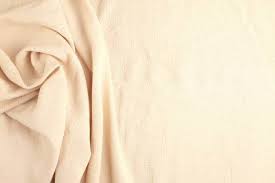
Cotton cloth with a simple weave is called muslin. It is produced in various weights, from delicate sheers to thick sheets. It is named after the Iraqi city of Mosul, where it was initially produced.
Traditionally, only cotton was used to make muslins. These textiles were very thin, translucent, fragile, and light as a feather. The warp may have 1000–1800 threads.
Procedure of manufacturing:
Since everything was done manually, yarn spinning and weaving required many artisans, yet the fabric and weaving took center stage.
Ginning: Using a boalee (the top jaw of a catfish), the fibers were cleaned, combed, and made uniform in preparation for spinning.
Spinning and weaving: To give the yarns more flexibility and prevent breakages, they often use this fabric to weave and spin during the monsoon season. Due to the slow process, a muslin fabric might be woven in more than five months.
Uses:
- Stitching Clothes:
While cutting out pieces from pricey fabric to sew garments, a sewist may evaluate the fitting of an outfit using a cheap muslin fabric to prevent potentially expensive errors.
Muslin is frequently available in extended widths in the quilt department of fabric stores since it is frequently used as a liner quilt during backing.
- Production of Food:
To maintain a liquidy sturdy (for instance, when it is about to make cheese at home, and the milk has fermented to a cream, drizzle into a muslin pouch and squash among two saucers (inverted under a concrete block) to wiggle out the liquid greek yogurt from the spoiled milk);
In a siphon, if decanting fine wine or connector to avoid silt from entering the cask;
To detach liquid from puree (e.g., to squeeze apple juice: rinse, sliced, mashes the boiled fruits and then pours the mashed material into the muslin fabric by suspending it over a jar or a container.
The traditional muslin is used to encircle a Christmas dessert.
Beekeepers sift molten beeswax through muslin fabric to remove impurities and dirt.
- Photography:
For stage sets, muslin is frequently the material of choice. It is employed to disguise set backgrounds and create the mood or vibe of specific settings. It takes paint nicely and may be turned transparent with the proper processing.
It retains colors nicely as well. It is frequently used to generate evening images because once dyed, and it frequently takes on a wavy appearance with a hue that varies gradually, resembling a night sky. This fabric contracts when painted or washed with water, which is advantageous for several typical methods like soft-covered flats.
Muslin is the most typical backdrop fabric employed by photographers for formal picture backdrops. Generally painted, these backgrounds frequently have an artistic mottled texture.
- Medicine:
In vascular surgery, surgeons tie muslin over aneurysms or brain arteries at danger of bleeding. According to the theory, the fabric strengthens the artery and prevents collapse. It is frequently utilized for aneurysms that cannot be cut or wrapped due to microscopic size or form.
Final Verdict:
A flexible, all-purpose fabric called muslin has been used in everything from dressmaking to furniture polishing to stage settings and perhaps medicine. Most significantly, it is recyclable and breaks the waste cycle. It is a clean, natural fabric used throughout the house without dispersing chemical residue. Muslin is the most typical backdrop fabric employed by photographers for formal picture backdrops. Generally painted, these backgrounds frequently have an artistic mottled texture.
Leave a Reply